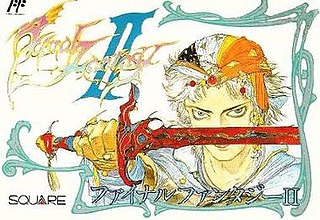
Final Fantasy II is a fantasy role-playing video game developed and published by Square in 1988 for the Family Computer as the second installment of the Final Fantasy series. The game has received numerous enhanced remakes for the WonderSwan Color, the PlayStation, the Game Boy Advance, the PlayStation Portable, iOS, Android and Windows. As neither this game nor Final Fantasy III were initially released outside Japan, Final Fantasy IV was originally released in North America as Final Fantasy II, so as not to confuse players. Following enhanced versions for iOS and Android in 2010 and 2012 respectively, the game was re-released again as part of the 2021 Final Fantasy Pixel Remaster series.

Final Fantasy IV, titled Final Fantasy II in its initial North American release, is a role-playing video game developed and published by Square for the Super Nintendo Entertainment System. Released in 1991, it is the fourth main installment of the Final Fantasy series. The game's story follows Cecil, a dark knight, as he tries to prevent the sorcerer Golbez from seizing powerful crystals and destroying the world. He is joined on this quest by a frequently changing group of allies. Final Fantasy IV introduced innovations that became staples of the Final Fantasy series and role-playing games in general. Its "Active Time Battle" system was used in five subsequent Final Fantasy games, and unlike prior games in the series, IV gave each character their own unchangeable character class — although at a few points in the story, a dark knight will choose the path of a paladin, or a summoner will evolve to a new tier of spellcasting.
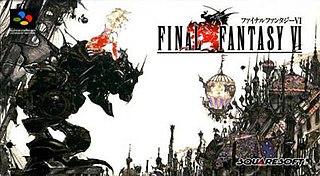
Final Fantasy VI, also known as Final Fantasy III from its initial North American release, is a 1994 role-playing video game developed and published by Square for the Super Nintendo Entertainment System. It is the sixth main entry in the Final Fantasy series, the final to feature 2D sprite based graphics, and the first to be directed by someone other than series creator Hironobu Sakaguchi; the role was instead filled by Yoshinori Kitase and Hiroyuki Ito. Long-time collaborator Yoshitaka Amano returned as character designer and concept artist, while composer Nobuo Uematsu returned to compose the game's score, which has been released on several soundtrack albums.

Final Fantasy V is a fantasy role-playing video game developed and published by Square in 1992. It is the fifth main installment of the Final Fantasy series. The game first appeared only in Japan on Nintendo's Super Famicom. It has been ported with minor differences to Sony's PlayStation and Nintendo's Game Boy Advance. An original video animation produced in 1994 called Final Fantasy: Legend of the Crystals serves as a sequel to the events depicted in the game. It was released for the PlayStation Network on April 6, 2011, in Japan. An enhanced port of the game, with new high-resolution graphics and a touch-based interface, was released for iPhone and iPad on March 28, 2013, for Android on September 25 the same year and for Windows on September 24, 2015. A more enhanced re-release of the game as part of the Final Fantasy Pixel Remaster series, was released on November 10, 2021 for Android, iOS, and Windows, and for Nintendo Switch and PlayStation 4 on April 19, 2023.

The Mana series, known in Japan as Seiken Densetsu, is a high fantasy action role-playing game series created by Koichi Ishii, with development formerly from Square, and is currently owned by Square Enix. The series began in 1991 as Final Fantasy Adventure, a Game Boy handheld side story to Square's flagship franchise Final Fantasy. The Final Fantasy elements were subsequently dropped starting with the second installment, Secret of Mana, in order to become its own series. It has grown to include games of various genres within the fictional world of Mana, with recurring stories involving a world tree, its associated holy sword, and the fight against forces that would steal their power. Several character designs, creatures, and musical themes reappear frequently.

Dragon Quest II: Luminaries of the Legendary Line, titled Dragon Warrior II when initially localized to North America, is a role-playing video game developed by Chunsoft and published by Enix in 1987 for the Nintendo Entertainment System as a part of the Dragon Quest series. Enix's U.S. subsidiary published the American release, Dragon Warrior II, for the Nintendo Entertainment System in 1990. Dragon Quest II is set one hundred years after the events of the first game.
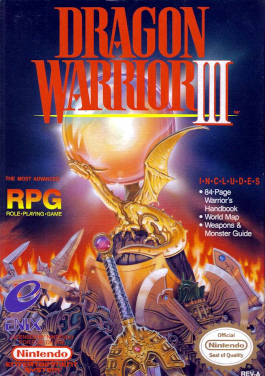
Dragon Quest III: The Seeds of Salvation, titled Dragon Warrior III when initially localized to North America, is a 1988 role-playing video game developed by Chunsoft and published by Enix. It is the third installment in the Dragon Quest series and was first released for the Family Computer (Famicom) in Japan and later for the Nintendo Entertainment System (NES) in North America. The game saw an enhanced remake for the Super Famicom in 1996 and the Game Boy Color in 2001, and a port to mobile phones and the Wii in 2009 and 2011. A version of the game for Android and iOS was released in Japan on September 25, 2014, and worldwide as Dragon Quest III: The Seeds of Salvation on December 4, 2014. It was the first time the game was given an official English subtitle. Later in 2021, another remake of the game titled Dragon Quest III HD-2D Remake, based on Octopath Traveler's style, was announced during the franchise's 35th anniversary livestream.
Final Fantasy is a media franchise created by Hironobu Sakaguchi and owned by Square Enix that includes video games, motion pictures, and other merchandise. The series began in 1987 as an eponymous role-playing video game developed by Square, spawning a video game series that became the central focus of the franchise. The music of the Final Fantasy series refers to the soundtracks of the Final Fantasy series of video games, as well as the surrounding medley of soundtrack, arranged, and compilation albums. The series' music ranges from very light background music to emotionally intense interweavings of character and situation leitmotifs.
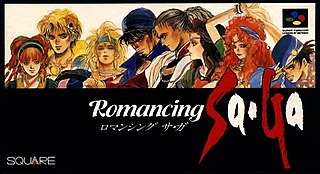
Romancing SaGa is a 1992 role-playing video game developed and published by Square for the Super Famicom. It is the fourth entry in the SaGa series. It was subsequently released for the WonderSwan Color in 2001 and mobile phones in 2009. A remake for the PlayStation 2, subtitled Minstrel Song in Japan, was released in both Japan and North America in 2005 by Square Enix. A remaster of Minstrel Song was released worldwide in 2022 for Android, iOS, Nintendo Switch, PlayStation 4, PlayStation 5 and Windows.

Final Fantasy Legend III, known in Japan as SaGa 3: Jikuu no Hasha, is a role-playing video game developed and published by Square for the Game Boy. The third entry in the SaGa series, it was released in Japan in 1991 and in North America in 1993. A remake for the Nintendo DS was released in 2011 by Square Enix, remaining exclusive to Japan. The Game Boy version was later ported to the Nintendo Switch and released worldwide by Square Enix in 2020, with later ports to Android, iOS and Microsoft Windows in 2021.

Akitoshi Kawazu is a Japanese game designer, director, producer and writer. After joining Square in 1985, he went on to become a central developer for the first two Final Fantasy titles, then acted as creator and lead developer for the SaGa series.
The music of the video game Final Fantasy IV was composed by regular series composer Nobuo Uematsu. The Final Fantasy IV Original Sound Version, a compilation of almost all of the music in the game, was released by Square Co./NTT Publishing, and subsequently re-released by NTT Publishing. It was released in North America by Tokyopop as Final Fantasy IV Official Soundtrack: Music from Final Fantasy Chronicles, with one additional track. It has since been re-released multiple times with slight changes as part of the Final Fantasy Finest Box and as Final Fantasy IV DS OST. An arranged album entitled Final Fantasy IV Celtic Moon, containing a selection of musical tracks from the game performed in the style of Celtic music by Máire Breatnach, was released by Square and later re-released by NTT Publishing. Additionally, a collection of piano arrangements composed by Nobuo Uematsu and played by Toshiyuki Mori titled Piano Collections Final Fantasy IV was released by NTT Publishing.
The music of the video game Final Fantasy III was composed by regular series composer Nobuo Uematsu. Final Fantasy III Original Sound Version, a compilation of almost all of the music in the game, was released by Square Co./NTT Publishing in 1991, and subsequently re-released by NTT Publishing in 1994 and 2004. The soundtrack to the remake of Final Fantasy III for the Nintendo DS, Final Fantasy III Original Soundtrack was released by NTT Publishing in 2006, with revamped versions of the tracks and additional tracks. A vocal arrangement album entitled Final Fantasy III Yūkyū no Kaze Densetsu, or literally Final Fantasy III Legend of the Eternal Wind, contained a selection of musical tracks from the game. The tracks were performed by Nobuo Uematsu and Dido, a duo composed of Michiaki Kato and Shizuru Ohtaka. The album was released by Data M in 1990 and by Polystar in 1994.

Final Fantasy Dimensions is a role-playing video game developed by Matrix Software and published by Square Enix for mobile devices. Similar to Final Fantasy IV: The After Years, it was initially released as an episodic game, with the first two installments released in September 2010 on the Japanese i-mode distribution service, and in December 2010 for the EZweb distribution service. The game was remade for the iOS and Android platforms and released internationally in August 2012.
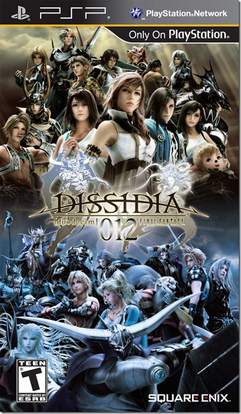
Dissidia 012 Final Fantasy is a fighting game published by Square Enix for the PlayStation Portable as part of the Final Fantasy series. It was developed by the company's 1st Production Department and released worldwide in March 2011. The game is both a prequel and remake of Dissidia Final Fantasy, revealing what occurred before the events of its predecessor.

Final Fantasy is a fantasy role-playing video game developed and published by Square in 1987. It is the first game in Square's Final Fantasy series, created by Hironobu Sakaguchi. Originally released for the NES, Final Fantasy was remade for several video game consoles and is frequently packaged with Final Fantasy II in video game collections. The first Final Fantasy story follows four youths called the Warriors of Light, who each carry one of their world's four elemental crystals which have been darkened by the four Elemental Fiends. Together, they quest to defeat these evil forces, restore light to the crystals, and save their world.

Final Fantasy X/X-2 HD Remaster is a high-definition remaster of the role-playing video games Final Fantasy X (2001) and Final Fantasy X-2 (2003), originally developed by Square on the PlayStation 2 in the early 2000s. It also features story content previously only found in the International versions, and a new audio drama set a year after the events of X-2. The collection saw graphical and musical revisions and is based on the international versions of both games, making certain content accessible to players outside of Japan for the first time.

Stranger of Paradise: Final Fantasy Origin is an action role-playing game in the Final Fantasy series developed by Koei Tecmo's Team Ninja, and published by Square Enix in celebration of the series' 35th anniversary. As an alternate universe prequel of Square Enix's original Final Fantasy on the NES, the storyline follows a set of characters brought into a fantasy world to face the malevolent Chaos. The game was released in March 2022 for PlayStation 4, PlayStation 5, Windows, Xbox One, and Xbox Series X/S.

Final Fantasy III is a Nintendo DS role-playing video game and a remake of the 1990 Family Computer game, Final Fantasy III.

















